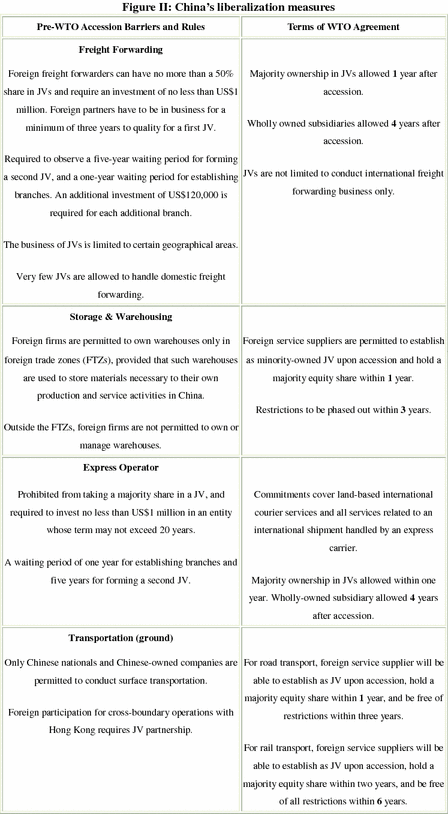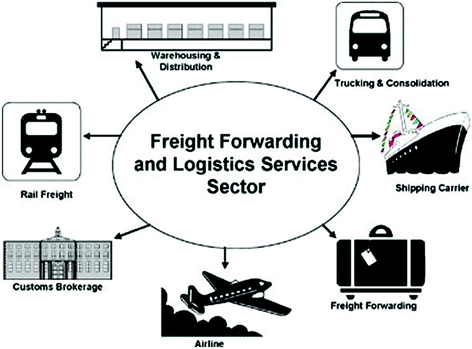An Overview of China’s Modern Logistics Development and Some Strategic Actions

240 billion ($29 billion), after just 2 years of expansion.7 Also, the total value of China’s domestic logistics in the first quarter of 2004 arrived at RMB  8.21 trillion (US$993 billion), 31.7 % higher than the corresponding period in 2003, according to statistics from the National Logistics Information Center in 2004.8 The sector has changed significantly as a result of overall market growth, evolving customer requirements, liberalization of government policies, and China’s WTO entry.
8.21 trillion (US$993 billion), 31.7 % higher than the corresponding period in 2003, according to statistics from the National Logistics Information Center in 2004.8 The sector has changed significantly as a result of overall market growth, evolving customer requirements, liberalization of government policies, and China’s WTO entry.
6.3 Impact of WTO on Distribution and Logistics in China
The goal of the rules under the WTO is to help producers of goods and services, exporters, and importers conduct their business, while allowing governments to meet social and environmental objectives. The overriding purpose of the system is to encourage trade flow as freely as possible, so long as there are no undesirable side effects. In part, this means removing obstacles or barriers. It also means ensuring that individuals, companies, and governments know what the trade rules are around the world and giving them the confidence that there will be no sudden changes in policy. In other words, the rules have to be transparent and predictable.9
As a member of the WTO, China is to issue rules and regulations that fully comply with the above approach of the WTO, i.e., rules and regulations, including those in distribution and logistics that are transparent and predictable.
6.4 China’s Market Access Commitments on Logistics and Distribution
1.
Transport
Road transport
Foreign investors may establish joint ventures (hereinafter JVs) to handle freight transport by road upon accession. Majority-owned JVs and wholly owned subsidiaries will be allowed in the following year and 3 years, respectively.
Rail transport
Foreign investors may establish JVs to handle freight transport by rail upon accession. Majority-owned JVs and wholly owned subsidiaries will be allowed in 3 and 6 years, respectively.
Sea transport
Foreign investors may operate international sea freight and passenger service. Minority-owned JVs may register for operation under Chinese flag. Foreign investors may also set up JVs to operate auxiliary services such as cargo handling, container yard, and shipping agency.
2.
Freight Forwarding
Foreign freight forwarders with at least 3 years of experience may establish freight-forwarding JVs upon accession. Majority-owned JVs and wholly owned subsidiaries will be allowed in 1 and 4 years, respectively. JVs which have been in operation for 1 year or more may open branches. At present, a foreign freight forwarder with a JV in China for 5 years may set up a second JV. This requirement will be relaxed from 5 to 2 years.
3.
Storage and Warehousing
Foreign firms may establish warehousing JVs in China upon accession. Majority-owned JVs and wholly owned subsidiaries will be allowed 1 and 4 years after accession, respectively.
4.
Courier Service
Foreign firms may hold minority shares in forming JVs upon accession. Majority-owned JVs and wholly owned subsidiaries will be allowed in 1 and 4 years, respectively. JVs may provide postal services using one or more transport modes, except those services monopolized by the Chinese postal authorities.
5.
Road and Water Transport Infrastructure
Foreign firms may set up majority-owned JVs upon accession. Wholly foreign-owned enterprises will be allowed 3 years after accession, but certain limitations on the scope of contracts will remain.
6.
Port Facilities
Foreign firms may form JV shipping companies to provide international passenger and cargo services, with foreign equity capped at 49 %. Foreign investors may also set up JVs to offer shipping agency, cargo handling, and container yard services. Foreign vessels may have access to port facilities in China. Wholly foreign-owned vessel inspection service will be allowed 4 years after accession.
In the meantime, wholly foreign-owned enterprises can undertake infrastructure projects related to water transport on a conditional basis. According to the latest “Catalogue for the Guidance of Foreign Investment Industries” which took effect on April 1, 2002, Chinese majority shareholding is no longer required for the operation of public wharves.
In keeping with China’s WTO commitments, the majority of projects relating to logistics development are classified as encouraged. Only a small number of them are listed under the restricted and prohibited categories:
7.
Encouraged
Construction and operation of rail trunk lines (Chinese majority shareholding required); railway branch lines, local railways and connecting bridges, tunnels and ferry service (restricted to JVs only); roads, bridges, and tunnels; public wharf facilities; civilian airports (Chinese majority shareholding); warehousing facilities related to transport service. Freight service by road and air (Chinese majority shareholding); general aviation service for agricultural, forestry and fishery sectors (restricted to JVs only); scheduled and non-scheduled international sea transport service; and international, inter-modal container freight service. Multimedia is popular.
8.
Restricted
Cross-border trucking, water transport, rail freight, and agency business (shipping, freight service, cargo handling on board foreign vessels, and advertising, etc.).
9.
Prohibited
Although postal service is classified as prohibited, foreign investors may still invest in market segments that are not reserved for the Chinese postal authorities. For instance, courier service is open for foreign participation. In fact, DHL, UPS, and FedEx are already operating in the China market. Further, a series of new measures adopted in recent years on foreign investment in water transport, rail cargo transport, and freight forwarding marked the gradual relaxation of certain activities under the restricted category (Figs. 6.1 and 6.2).10


Fig. 6.2
China’s liberalization measures. Source Loo, ibid
6.5 China’s Market Access Commitment with Regard to Distribution
In the USA–China bilateral WTO agreement, China’s commitment with regard to distribution is comprehensive, covering commission agents’ services, wholesaling, retailing, and franchising. In each of these sectors, commitments on market access, national treatment, and other areas have been made under which there are four forms of supplying services, including cross-border delivery, offshore consumption, commercial presence, and movement of natural persons.
Market access is the most crucial of all issues. China agrees to gradually liberalize the wholesaling and retailing of all but a few commodities within 5 years of accession. Quantitative, geographical, equity, and incorporation restrictions on the establishment of JVs by foreign companies will also be phased out. This is bound to have a considerable impact on China’s distribution enterprises, but will also bring them a host of business opportunities.11
In line with its commitments to the WTO, China will further reinforce its opening up of the retailing sector. After December 11, 2004, restrictions on geographical location, equity participation, and the number of foreign-invested retail enterprises were removed.
By now, most of the multinational retail giants have entered China. In 2003, the annual revenue of Carrefour reached RMB 13.4 billion (USD 1.62 billion), an increase of 25.7 % over the previous year. Walmart has opened 33 branch stores in China, and its annual sales reached RMB 5.85 billion (USD 708 million) in 2003.
Experts indicated that foreign investment in the retailing sector is still very low in China. Foreign-invested retailing is mostly concentrated in the eastern part of China and is mostly in the form of hyper-markets.
As the opening up gradually takes place, there will be more types of retailing and more companies in the central and western part of China, whereas the Deputy Minister of Commerce, Mr. Zhang Zhigang, pointed out that currently, the logistics industry in China is still relatively weak. The opening up of the retail industry will impact the logistics industry and bring new opportunities to it.12
6.6 China’s Logistics Barriers Is Scheduled to Be Knocked Down in 2005
The year 2005 should prove to be an extraordinary year for the logistics industry. According to its WTO agreements, China will completely open its logistics market. In 2005, China will grant international companies equal footing in its domestic logistics market. China is also a signatory to “Closer Economic Partnership Arrangement (CEPA),” along with Hong Kong and Macao, and has opened the services market to the two regions.
The Ministry of Commerce officially issued “Provisions on the Establishment of Investment Companies by Foreign Investors” on June 27, 2004. According to the provisions, as a prelude to the complete opening of the logistics industry in 2005, foreign investors will be able to establish investment companies and invest in outsourcing of services, purchasing, and logistics in China. Meanwhile, the provisions also say that these investment companies can hold non-tradable corporate shares of domestic enterprises.13
6.7 Foreign Players Jostling for Position
Many of the world’s leading logistics giants have been in business in China for many years. These foreign firms have been operating in the mainland in the following three areas:
Many foreign firms team up with Chinese partners in offering 3PL services. For instance, Mitsui OKK Lines (MOL) of Japan and Fuji jointly operate a logistics and warehousing company in Suzhou to take care of all the logistics involved in making the Fuji film available across the China market. UPS’s JV logistics company plans to open 19 offices in China. DHL and Sinotrans have extended their JV agreement by 50 years.
Other foreign companies such as Exel Logistics, TNT, and Nippon Express are setting up offices or negotiating JV deals in Shenzhen and Guangzhou. The US$30 million logistics JV between TNT and Shanghai Automotive Industry Corp (Group) is the first of its kind in China specializing in the automobile sector. APL Logistics has formed JVs with two local transport giants in Shanghai and Shenyang to develop the mainland logistics market. APL Logistics currently has branch companies in 7 cities along the southeastern coast, with plans to expand to 12 cities over the next 2 years.
While many foreign companies team up with local partners, some prefer to go it alone. Typically, these companies provide 3PL service to foreign and domestic companies. The Maersk Group, since receiving the green light to enter the China market in 2001, has set up 11 branches across the country. It has also opened its first distribution center in Shanghai, with plans to set up 10 more. Meanwhile, Nippon Express has formed logistics companies in Dalian, Shenzhen, and Shanghai to facilitate business expansion in China. NYK Lines (China) has also established a branch in Shanghai and is now moving to set up logistics companies in Tianjin, Qingdao, Fuzhou, Xiamen, Guangzhou, and Dalian. OOCL has located its China headquarters in Shanghai with 21 offices all over the country.15
Foreign companies with strong international networks and better management are gaining market share, while many domestic companies rely on underdeveloped domestic operations. And local and regional distribution systems are replacing state-owned and centrally managed trading and distribution systems.
According to a report, jointly published by the China Federation of Logistics and Purchasing and Mercer Management Consulting (2002), the outsourcing of logistics and transportation will continue to expand by roughly 25 % annually through 2005 because of stronger global interest and demand for third-party services. Multinational companies (MNCs) relying on China as a global sourcing base are inclined to use—and are experienced in using—third-party services, especially those of third-party providers. More than 90 % of MNCs in China currently contract at least a portion of their logistics business to third parties.
Though the concept of outsourcing, these basic logistics functions are still relatively new to most Chinese companies, many leading foreign firms in China—such as McDonald’s Corp. and Dell Computer Corp—have demonstrated great success by using third-party service providers’ expertise, capabilities, and assets to offer nationwide distribution and logistics service. These foreign companies have shown Chinese companies that they do not need to own all of the assets involved in service provision to gain the capability and expertise to offer a full line of services.16
2.
Own logistics system
